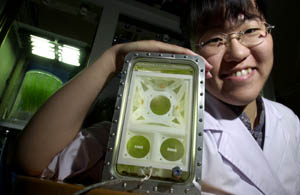
|
|
| Japan-US Science, Technology and Space Application Program |
|
|

|
|
|
第1回関係者 |
|
S*T*A*R*S |
|
第2回関係者 |
|
第10回日米科学・ |
|
実験装置の |
|
現在の状況 |
|
現在の状況 |
|
米国の新聞に |
|
|
 |
Ants, bees, fish going up
Some little critters are about to get a wild ride. Paragon Space Development Corp. furnishes the habitats that will orbit Earth on the space shuttle for 16 days next fall and is also hosting the Japanese graduate student designing the fish experiment. Maki Niihori, a biology student from Ochanomizu University in Tokyo, won a contest that brought her to Tucson for a two-month internship at Paragon, 810 E. 47th St. Niihori, 22, submitted a proposal for an experiment utilizing the Japanese Medaka fish, a hardy species used in a 1994 NASA shuttle mission. A Japanese researcher conducted an experiment to see if the fish would breed and produce eggs in space, Niihori said. "I was so moved by her work that I wanted to do the next step and study the behavior of fry (young fish) in space," she said. That next step will be conducted using Paragon's Autonomous Biological System technology, a self-contained life-support system. About the size of a cigar box, the sealed ecosystem features six tiny light bulbs and a combination of plant, animal and microbial life. "One of the things we specialize in is developing passively controlled life-support systems," said Jane Poynter, Paragon's CEO. "You don't use pumps and you don't have lots of moving parts and mechanisms." Instead, the ecosystem relies upon life itself to do the work. The aquarium plant produces oxygen for the fish, while the plant lives on light, carbon dioxide and nutrients produced by bacteria and organisms. Two wheat kernels provide food for the organisms, which in turn serve as food for the Medaka fry. The ground control experiment at Paragon includes gauges to monitor water temperature and pH, the degree of alkalinity or acidity. The organisms do such a good job of pulling the carbon out of the water that the pH actually runs high, but not high enough to affect the fertilized eggs and the fry they'll produce in the 16-day experiment, Poynter said. "Building an ecosystem as a life-support system is both a science and an art," she said. "There is only so much with these complex ecosystems you can measure and tweak. They have their own rules and you have to let them run by those rules." The fish habitat features netted enclosures to protect the fertilized Medaka eggs from potential predators like snails. When the eggs hatch, the fry will swim through tiny holes into a larger area. The eggs and fry will be monitored and recorded with video cameras, as will a similar ground control habitat at Paragon. The habitats for harvester ants and carpenter bees will not be completely sealed, to allow small quantities of air to come and carbon dioxide to escape. These habitats have screw lids that will be turned to just the right amount to allow this diffusion, Poynter said. The four carpenter bees will be housed in balsa wood enclosures in an experiment conducted by students from Lichtenstein, while the ants will tunnel in an agar-based gel in an experiment conducted by U.S. students. Agar, a gelatinous substance extracted from certain species of red seaweeds, provides the ideal medium for the ants, Poynter said. When sucrose and an anti-fungal agent are added, the gel not only serves as a tunneling medium, but also as the food source and the infection fighter for the ants, she said. Ants raised in captivity normally die in about three months, usually from fungal infections. The ants housed in agar-gel habitats at Paragon have survived for one and a half years and counting, Poynter said. The three habitats will join four other experiments housed in pressurized carriers that fit in the cargo bay of the shuttle mission STS-107. The mission has been delayed for 23 months, in part because of a refurbishment of the craft and to flights required to build and maintain the International Space Station. "Research flights have been cut down to almost zero because of the flights for the space station," said John Royston, spokesman for the Science and Technology Research Student Academy, known as STARS, a Florida-based educational company that sponsors the experiments. The academy, which provides educational programs for homeschoolers and students from public and private schools from nine countries, has a Paragon-built aquatic ecosystem on the Mir space station, which was launched on a Russian rocket in February. About 100,000 students enrolled in the academy program built similar ecosystems of their own to compare with the one currently thriving in space, Royston said. |
Copyright(C) JUSTSAP All Rights Reserved. 1999-
